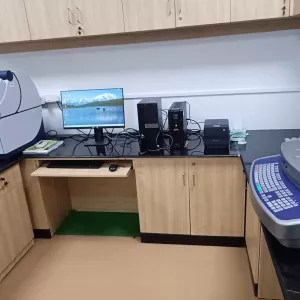Mainstreaming nutrition in CGIAR breeding: X-ray Fluorescence (XRF) services ready to scale
Reducing global undernutrition remains one of CGIAR’s most pressing opportunities for impact. For two decades, HarvestPlus has led investments in breeding crops enriched with zinc, iron, and provitamin A, ensuring that nutrition traits reach millions of farming households. Today, as CGIAR redefines its strategic priorities, nutrition is no longer a niche add-on – it is moving to the core of

Mainstreaming nutrition in CGIAR breeding: X-ray Fluorescence (XRF) services ready to scale
Reducing global undernutrition remains one of CGIAR’s most pressing opportunities for impact. For two decades, HarvestPlus has led investments in breeding crops enriched with zinc, iron, and provitamin A, ensuring that nutrition traits reach millions of farming households. Today, as CGIAR redefines its strategic priorities, nutrition is no longer a niche add-on – it is moving to the core of breeding programs particularly in target CGIAR regions that have higher malnutrition prevalences. And with it, nutritional analysis has become central too, now accessible to breeders worldwide through Breeding Resources.
A new strategic orientation: nutrition as a breeding priority
CGIAR breeding programs worldwide are shifting from a sole focus on yield, resilience, and agronomic performance to include essential nutritional traits. Target Product Profiles (TPPs) developed for each crop and market segment now identify micronutrients such as zinc, iron, and provitamin A and whether they are “must-have” traits for new varieties. Across CGIAR research portfolio, 15% of established TPPs include essential-to-improve micronutrient traits, highlighting the need for coordinated laboratory services to meet standards more quickly and cost-effectively.
“We’ve worked with CGIAR’s Better Diets and Nutrition Science Program to understand where we can have the most impact: which crops, which regions, and which nutrients to prioritize,” explained Peter Coaldrake, Interim Director of CGIAR Breeding for Tomorrow. “To stay on track, we need clear performance indicators so we can monitor progress and deliver the biofortified crop varieties we are committed to.”
“For breeders, this strategy orientation creates new demands. They need fast, cost-effective, high-throughput instruments to measure nutrition traits and make selection decisions within days, not months. Without this capability, mainstreaming nutrition into pipelines risks becoming aspirational rather than practical,” Coaldrake added.
Breeding Resources: enabling nutrition analysis at scale
This is where CGIAR’s Breeding Resources (BR) comes in. For the past few years, Breeding Resources – CGIAR’s provider of services for breeding and research – has established with HarvestPlus a global network of instruments and protocols to deliver consistent, high-quality data on nutrition traits, starting with X-ray fluorescence (XRF) services for zinc, iron, and provitamin A.
“At Breeding Resources, we don’t just pick up any service. We assess demand from breeding programs, identify gaps, and then decide what to add based on cost, quality, and turnaround time,” explained Rajaguru Bohar, Lab Services Manager, BR Global Shared Services. “Every product or service we provide is demand-driven, grounded in the needs of breeding pipelines.”
Unlike many complex lab techniques, XRF allows breeders to screen thousands of grain samples quickly and cost-effectively, providing the high-throughput capacity required for modern breeding. Breeding Resources’s role is to bring these services to the table while ensuring that they are:
- Harmonized across CGIAR Centers through shared calibration and quality control,
- Accessible to CGIAR and national programs through a service model, and
- Interoperable with digital breeding tools like Bioflow, CGIAR Breeding Analytics Pipeline, and the Enterprise Breeding System (EBS).
With this infrastructure, nutrition analysis can now be delivered to breeders as seamlessly as genotyping or trial data, helping them align products with Target Product Profiles that explicitly target improved diets.
HarvestPlus: a unique comparative advantage
To anchor this effort, Breeding Resources has partnered with HarvestPlus, the global leader in biofortification to add nutrition phenotyping particularly XRF services to its portfolio. HarvestPlus brings:
- Two decades of experience screening and mainstreaming nutrition traits into nine crops;
- Proven global reach with labs, calibration standards, and partnerships across Africa, Asia, and Latin America;
- Calibration networks and Standard Operation Procedures (SOPs) already harmonized across CGIAR and national partners;
- Policy engagement that has enabled nutrition traits to be embedded into varietal release systems in countries like India and Nigeria;
- Cost-recovery service models that ensure affordability and sustainability.
“This launch connects crops and regions, helping us move responsibly from targeted breeding and biofortification toward making nutrition a core part of CGIAR and NARES programs, aligned with their TPPs and market segment priorities,” said Govindaraj, Senior Scientist at HarvestPlus.
HarvestPlus pioneered the application of XRF in agriculture, adapting technology once used in mining and cement industries to measure micronutrients in staple crops. Today, its labs in India, Rwanda and Bangladesh can process up to 50,000 annually, providing the scale needed to mainstream nutrition across CGIAR’s breeding portfolio.
The services are already available through Breeding Resources’ Service Request Portal, CGIAR’s marketplace for shared services.

Toward nutrition at scale
By combining CGIAR’s new strategic orientation with Breeding Resources’ shared service model and HarvestPlus’ comparative advantage in XRF services, breeders now have the tools, data, and partnerships to make nutrition a standard feature of crop improvement.
This collaboration ensures that future varieties will not only yield more, resist stress, and thrive in diverse environments — they will also deliver better nutrition to millions of farming households worldwide.
Resources
- Access the XRF services from CGIAR Service Request Portal
- Event: Introducing XRF services to CGIAR and partner breeders
- Learn more about HarvestPlus
***
Main image: HarvestPlus’s XRF lab facility in India, specialized in multi-crop sample elemental analysis using the BR global shared service model. Credit: HarvestPlus. Written by Julie Puech. This work contributes to CGIAR Breeding for Tomorrow (B4T) Science Program through its Breeding Resources Area of Work.

